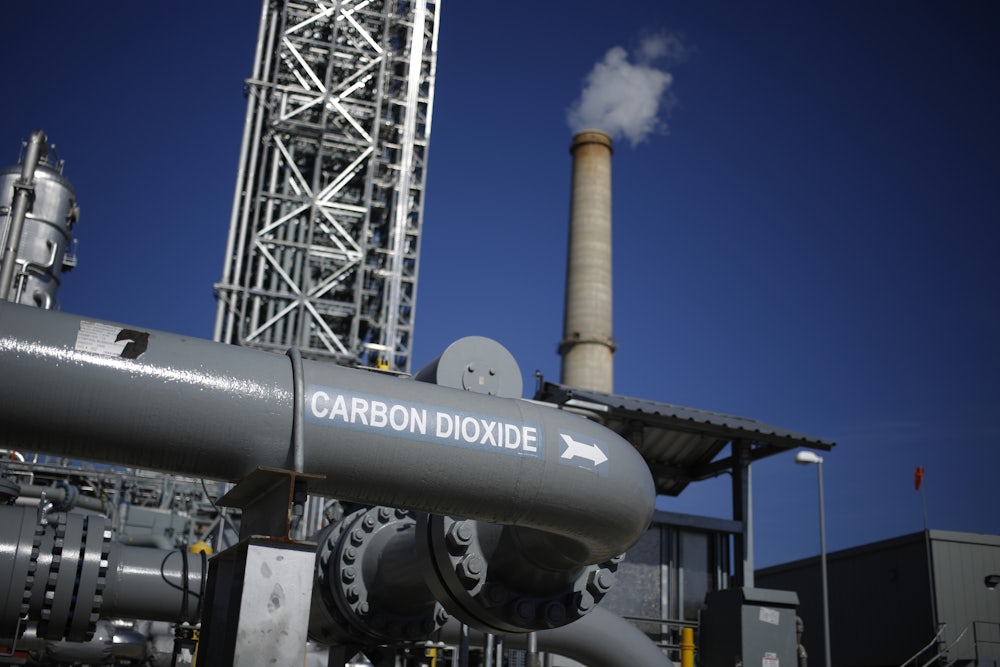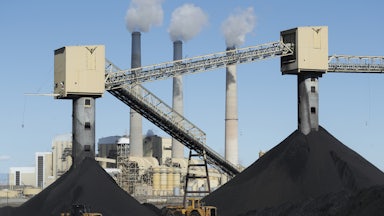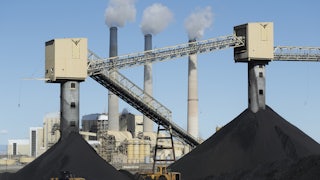Being able to capture carbon dioxide and store it underground has been a long-held dream of Republican and Democratic administrations alike. If governments fail to reduce emissions by the amount required to keep warming below 1.5 or two degrees Celsius (2.7 or 3.6 degrees Fahrenheit)—a scarily likely scenario—technology known as carbon capture and underground storage, or CCUS, offers the chance to claw those excess emissions back, keeping ambitious climate goals within reach.
But while it’s technically possible, CCUS remains prohibitively expensive. A slew of recent federal incentives have made it newly attractive for companies to start investing in it. As the United States pours billions into the project of capturing carbon, though, it has few plans in place to ensure this gargantuan build-out of new infrastructure performs the heroic tasks that climate models say it will need to.
There are also few guardrails against letting polluters have a say in how, exactly, that infrastructure gets built. Last summer, the Texas Railroad Commission, or RRC—the state’s oil and gas regulator—applied to the Environmental Protection Agency for the ability to oversee a key part of this process: the wells where carbon dioxide gets injected into rock formations deep underground for storage. Granting the application would mean that rather than the EPA making sure the wells are safe, the responsibility would switch to the RRC.
The Biden EPA has encouraged states to take charge of the permitting process, inviting them to apply for $50 million provided by the Bipartisan Infrastructure Act to administer that process. But last week, Texas Representatives Lloyd Doggett and Joaquin Castro, both Democrats, penned a letter to the EPA encouraging it to reject the RRC’s application.
“It would simplify matters to just send money directly to Exxon and ask them to self-report if they feel like,” Doggett told me over the phone, noting the uncapped donations the commission’s entirely Republican members receive from the fossil fuel industry.
So far, just two other states—North Dakota and Wyoming—have been given the authority to oversee the wells. Louisiana’s Department of Environmental Quality has also applied.
This interest in CCUS from major oil- and gas-producing states isn’t a coincidence. For the fossil fuel industry, the technology represents the potential to continue expanding oil and gas production while saving face with more climate-conscious policymakers and investors. Just last week, ExxonMobil acquired the owner of the country’s largest network of carbon storage and transportation infrastructure.
As a result, some, like Castro and Doggett, are raising red flags about passing the responsibility of overseeing carbon management to officials deeply enmeshed in their states’ fossil fuel economies. The RRC, for instance, is a notoriously captive agency whose commissioners accept generous contributions from the fossil fuel industry and themselves have direct ownership stakes in drilling firms.
As the federal government continues to roll out incentives to bring down emissions, the emerging fight over who will govern that burgeoning national network of carbon capture and storage facilities highlights the limits of coaxing the private sector into building critical, volatile infrastructure. The question is whether companies with long track records of delaying progress on climate change—and the politicians they donate to—should be trusted to oversee a major piece of solving it.
The International Energy Agency, or IEA, projects that a vast build-out of carbon capture infrastructure will be needed to meet the Biden administration’s stated goal of keeping global average temperatures from rising 1.5 degrees Celsius above preindustrial levels. As of now, almost all of the carbon captured in the U.S. is injected into depleted oil wells to unearth more fossil fuels through a process known as enhanced oil recovery, or EOR.
The Biden administration has made carbon capture a major part of its climate agenda, devoting more than $1 billion for carbon removal and expanding tax credits that incentivize it. But these subsidies are a blunt tool. Carbon capture, storage, and utilization is a broad category that can describe very different sorts of infrastructure used for very different things.
Perhaps the clearest-cut case for CCUS is to reduce emissions from industrial processes that are difficult to decarbonize. Cement production, for instance—responsible for 7 percent of global emissions—produces carbon dioxide as a result of certain chemical reactions. Carbon scrubbers could capture the resulting emissions and potentially inject them back into the finished concrete to strengthen it.
Much more controversial is the use of CCUS in the power sector. Capturing carbon dioxide from coal- and gas-fired power plants is tremendously expensive and energy-intensive, but utilities have been keen to use it as a means of keeping fossil fuel generators up and running despite pollution. Attempts to do that so far haven’t been promising. Southern Company’s Kemper County, Mississippi, CCS plant, for instance, was designed to turn carbon captured from coal burned to generate electricity into natural gas. The project was initially projected in 2010 to cost $2.4 billion; over the next decade the bill ballooned to $7.5 billion. Southern Company eventually scrapped Kemper’s carbon capture ambitions entirely, imploding that portion of its site while mandating the rest of the plant run on methane gas.
Many of the federal government’s incentives don’t differentiate between different types of CCUS. Those very useful cement plant scrubbers are eligible for the same type of tax breaks as an expensive, ineffective mechanism like Kemper’s. There’s some merit to that approach—but policymakers should be cautious, said University of Notre Dame civil engineer and environmental sociologist Emily Grubert.
“A lot of the same regulatory structures and infrastructure you need for the bad stuff is very similar to what you need for the good stuff,” she told me. “It’s really important to understand what this infrastructure looks like if you’re trying to accomplish one set of goals with carbon management versus another set of goals. I would hate to see us lose the opportunity to meet goals on mitigation and global justice because we ceded all of the initial governance questions to the industry.”
There are real stakes, as well, for the administration in being able to show proof-of-concept for carbon capture. In its decision last summer in West Virginia v. EPA—a suit brought by state Republican attorneys general against Obama’s Clean Power Plan rules—the Supreme Court ruled that the EPA only has jurisdiction to set rules for individual power-generating facilities, not for the power sector overall, and can’t mandate that polluters use any particular methods to reduce emissions. New power plant rules proposed by the Biden administration last month, accordingly, would set targets for individual plants to reduce their emissions so long as they are reasonably able to use the “best system of emission reduction”—a menu of options that includes carbon capture.
Though no commercial power plant in the country is successfully using carbon capture—there are just two such facilities on earth—the Inflation Reduction Act’s expansion of tax credits available for that technology has enabled the EPA to assert that it’s viable and demand much more aggressive cuts to plant emissions as a result. Showing that carbon capture actually works, in other words, is important for the Biden administration to insulate new power plant rules against a virtually inevitable legal challenge. Key to that is having a place to put all that carbon plants are capturing—and, by extension, getting permits out the door that allow companies to inject it into the earth.
The administration would have plenty of cause for wanting to take that decision-making out of its own hands and award it to states that might be able to do it faster. Massive amounts of carbon storage will be needed if power plants really do capture carbon at the rate EPA alleges they can. That storage is also a prerequisite for decarbonizing industrial processes. Given the potential scope of carbon storage the IEA suggests is needed, a successful national effort to expand carbon capture could easily overwhelm the EPA’s already limited capacity to oversee injection-well permitting.
But the importance of carbon capture to the fossil fuel industry means that the state agencies that have been most eager to apply for authority over the injection wells—including the RRC—are those with close ties to oil and gas. The promise of speedy approvals may well be good news to the White House now. Critics caution that meeting the short-term goal of green-lighting more permits could come at the long-term expense of both climate goals and public safety.
Concentrated carbon dioxide can pose massive risks. Speaking before a Texas Senate Committee earlier this year, Ageron Energy CEO Bruce Gates recounted when his employees tried to drill a well through a plume of carbonic acid—what happens when stored carbon dioxide comes into contact with water. After 12 hours, he said, the plume “completely bifurcated” a heavy-duty five-inch drill pipe, forcing the company to leave the 10,000-foot-deep oil they were hoping to access underground.
“It ate through it that fast,” he said. “If it eats through that drill pipe that fast, what do you think it’s doing to casing in the old legacy wells? It’s eating through them.”
Transporting carbon dioxide over pipelines can pose even greater risks. In 2020, a pipeline carrying a mixture of compressed carbon dioxide mixed with hydrogen sulfide burst in Sitartia, Mississippi, blanketing the small town in an eerie green haze. Those inside the cloud reported convulsions and fainting; in high concentrations, carbon dioxide is an asphyxiate. Cars driving through the cloud shut down as exhausts stopped taking in enough oxygen to power engines. In all, 45 people were hospitalized.
Then there’s the worry that all these technologies simply won’t capture carbon at anywhere near the levels that climate models say is necessary. It’s not hard to imagine that scenario: There is no federal agency ensuring that they actually reduce greenhouse gas emissions. While the IRS is meant to ensure that companies accepting tax credits actually store carbon, it has neither a framework for nor a mandate to evaluate the impact that policy is having on the climate. That agencies angling to oversee that process are in bed with the polluters should raise even more alarm bells, as Doggett and Castro have in Texas.
“The RRC will have little or no concern about how much carbon is getting permanently sequestered,” Doggett told me.
Though commissioners are supposed to recuse themselves from deciding on matters in which they have a “personal or private interest,” that seldom happens. A 2021 report from the Texas-based nonprofit Commission Shift outlines RRC members’ many financial ties to the companies they are charged with regulating. In just one example, Commissioner Christy Craddock cast the deciding vote to not fine a pipeline company in which she owns at least $17,000 worth of stock for groundwater contamination. She owns at least $1.5 million in oil and gas assets overall.
“The industry wants the RRC to have primacy because Texas has some of the highest potential for geological carbon storage,” Commission Shift Executive Director Virginia Palacios explained, noting the state’s expansive saline aquifers. “The industry has its sights on Texas as a dumping ground for carbon dioxide, but they need a state agency that is willing to easily grant permits.”
The state of CCUS in the U.S. should raise larger concerns about the country’s ability to decarbonize—namely, that the U.S. does not have a comprehensive plan for reducing its emissions. U.S. climate policy relies primarily on using the tax code to incentivize companies to grow specific industries that are helpful for decarbonization. The hope is that enough private-sector firms will see it as in their best interest to develop and deploy an awe-inspiring amount of world-saving infrastructure. The success of that approach, though, is measured in investment—not greenhouse gas reductions.
Companies’ only goal with CCUS is to make money. That could be made through the reputational benefits of investing in something climate-related, or harvesting carbon that can yield more oil, or charging rents to other companies to store carbon in their network of pipes and wells. That tax credits are the only thing making this practice profitable is troubling, particularly given how fickle the fossil fuel industry has been about its low-carbon investments. As climate change rose to the top of policymakers’ agenda in the lead-up to the Paris climate talks in 2015, drillers went out of their way to broadcast new ventures in everything from wind and solar to more far-flung projects like algae biofuels. But in recent months, with oil and gas extraction more profitable than ever, even European producers Shell and BP—typically more climate-conscious than their U.S.-based counterparts—have doubled down on extraction and are ditching renewables, citing low returns.
Is there a stronger business case for capturing carbon? Besides subsidies, much of the current revenue from capturing carbon comes from using it to unearth more fossil fuels via EOR. Storing it underground forever is much less glamorous. If the oil majors pouring money into carbon capture now eventually get bored or fed up with potentially low returns, they could do the same thing with unwanted carbon-management infrastructure that they do with all their other unwanted assets: sell them, typically to much smaller, more secretive companies with little interest in even playing lip service to climate goals. Those assets could eventually become the government’s responsibility, like the estimated three million orphaned and abandoned wells currently leaking pollutants like methane and benzene into the air and water. Carbon might not stand a better chance of staying buried.
Rather than looking to maintain what little control they have over where and how carbon-management infrastructure gets built, meanwhile, federal officials—fearing the limits of their own capacity—are actively trying to give it away. Those powers risk being ceded to state agencies dripping in cash from fossil fuel interests, if not populated by actual fossil fuel shareholders. Putting governance over CCUS in those hands presents an on-ramp for polluters to set the rules of the road for a method of reducing emissions that they might lose interest in at any moment. What money is there, after all, in being a security guard for some rocks 10,000 feet underground?










